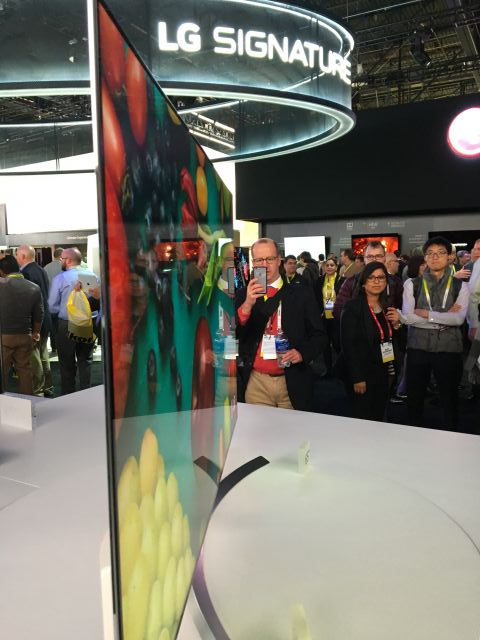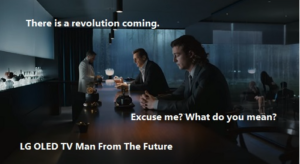If you were among one of the 111.5 million viewers of Sunday’s Superbowl here in the US, there’s a good chance you also viewed a host of blockbuster commercials that themselves boast production budgets now swelling beyond the cost of a full feature film.

A case in point was LG with its first ever “Man from the Future” Superbowl ad for the Signature OLED 4K Smart TV claiming a revolution coming with themes that hark back to the now famous “1984 ad” from, then fledgling, Apple Computer.
 Sir Ridley Scott’s groundbreaking 1984 Superbowl Ad for the Apple Macintosh launch help change everything in computing, and everything about viewing TV Superbowl Ads as well
Sir Ridley Scott’s groundbreaking 1984 Superbowl Ad for the Apple Macintosh launch help change everything in computing, and everything about viewing TV Superbowl Ads as well
If that characterization rings true it’s primarily because LG spared no expense, turning to the iconic production team of Sir Ridley and Jake Scott. Sir Ridley, who directed the ground-breaking Macintosh Launch Ad for Apple, now considered the best TV ad ever produced (by TV Guide), and known for changing TV advertising by helping elevate Superbowl ads into the realm of “entertainment.” For its part, Apple reaped the benefits of its big budget gamble with $150M in sales in the first 100 days of the Macintosh launch. His son, Jake Scott, is known for his acclaimed “Lost Dog” Budweiser Superbowl ad. The pair turned to a second father amd son team to appear in the ad, that of Liam and Micheal Neeson who were featured in the “Man from the Future Ad“.
LG1 Sunday night in the US, LG sponsored its first Superbowl commercial touting a revolution in the future of TV, Source: LG
For its part, LG sees its new Signature OLED brand as a groundbreaking TV with design and performance milestones that the company considers, well, revolutionary. It touts a 0.1-inch thin display on a 70-inch platform, translucent glass back and a powerful, forward-facing sound bar speaker system, all helping to create a sexy design. But its OLED technology is hardly a revolution in TV specs, or in improved performance that would match the advances Apple introduced with the Macintosh in 1984 with its graphic user interface, and all-in-one (and somewhat portable) design.
Still LG’s move to OLED, albeit W-OLED and using a similar color filter as LCDs, may indeed be the future of TV technology, perhaps sans the “revolution”. Like Plasma displays, the emissive OLED does generate excellent blacks and offers response times several orders of magnitude faster than the more complex, light-gating, LCD technology.
Consider too, that LG’s Korea-based rival, Samsung, said (according to the Korea Times), it was again looking at OLED technology for large screens and they will again proceed with projects for the development The idea was confirmed by Merck which indicated that Samsung will indeed be supplying OLEDs in 2017. Both were covered in recent Meko published stories (subscription needeed).
 LG’s Signature Series OLED TV shown at CES 2016 last month was featured in that company’s first ever Superbowl ad with help from father-son teams of Sir Ridley and Jake Scott (Producer Director) plus featuring on-air, Liam and Micheal Nesson Source: Steve
LG’s Signature Series OLED TV shown at CES 2016 last month was featured in that company’s first ever Superbowl ad with help from father-son teams of Sir Ridley and Jake Scott (Producer Director) plus featuring on-air, Liam and Micheal Nesson Source: Steve
LG said it plans to produce 200K OLED panels per quarter with a goal of 1M OLED units in 2016. The company said +65-inch size displays should generate 40% of total OLED output, but the popular 55-inch diagonal panels are expected to dominate the OLED category for LG. Back in January LG said it’s OLED production numbers reached 400K units in Q4-15 with half selling in that quarter alone. But to put that in perspective, it’s still a rounding error when compared to LCD’s dominance in the TV space, and perhaps what the LG ad was getting at with its “OLED TV Man From the Future” Superbowl 50 Ad.
Unlike Ridley’s 1984 Apple Ad, this one didn’t make the top 10 memorable commercials among the 40 some ads that played, according to a Mae Anderson AP story.
But perhaps the real question that remains is just how far ahead in the future did Liam have to travel to deliver the OLED TV revolution message? Many in the industry would caution not to count out the resilience of LCD TV and the staying power of an entrenched technology. After all, CRTs dominated for some 50 years, and are still sold in some smaller markets today. So while a revolution in TV technology may be in the making, for OLED we expect it to be a very S-L-O-W one indeed. – Steve Sechrist

